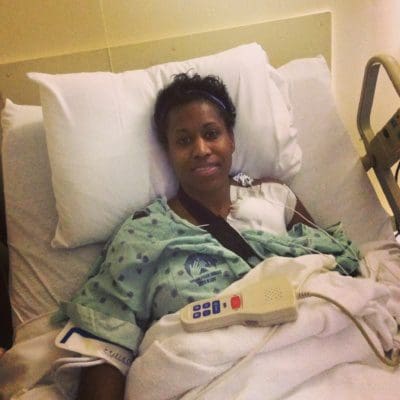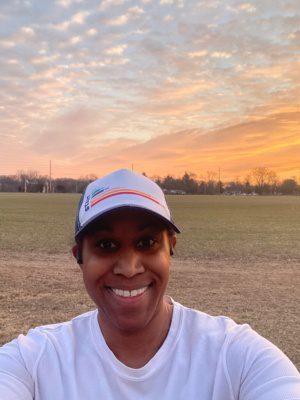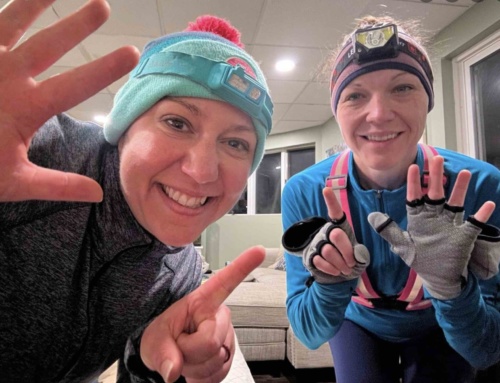After being diagnosed with a serious heart condition, mother runner and Many Happy Miles strength coach Brandi Dockett has been living with a pacemaker since 2014. Here, she shares how she’s thriving—and why she’s more grateful than ever.
–as told to Sarah Wassner Flynn

Many Happy Miles strength coach and heart warrior Brandi Dockett completes a sprint triathlon.
The first sign that something was wrong with my heart came in college. I’d sometimes feel lightheaded or come close to blacking out, but at the same time, I was living the lifestyle of staying out late and partying. It was easy to pass these symptoms off, especially because I also had migraines. In fact, my doctor said my symptoms sounded like ocular migraines, so they put me on medication for that and I was able to live with it.
Flash forward nearly two decades later, when I was training for a marathon as a 41-year-old mom of two. I began getting that lightheaded feeling again, along with heart palpitations and chest pain. At first, I thought it was just a “normal” part of training and pushing my body. But after getting it checked out, my doctor eventually told me otherwise: I had a third-degree atrioventricular (AV) block. The electrical signal that controls my heartbeat is completely blocked, causing my heart to stop for nine seconds at a time. The crazy thing is that these episodes occur in my sleep, so it was pretty hard to diagnose. It took a lot of testing to figure out just what was going on.
Besides, I was so fit! As a personal trainer, I spend my days with clients and teaching spin classes. Plus at the time, I was training for that marathon. But this type of blockage can happen to anyone. I had just learned to function with it. My doctor said that if I wasn’t as healthy, the condition could have killed me.
An even harder truth to swallow? I could no longer just get by as I’d had for so many years. My doctor recommended having a pacemaker implanted, which would work like a backup electrical system to remind my heart to beat at a normal rate if it slows or stops. Giving the severity of my blockage, I really had no choice. It was literally do or die.

Brandi recovering from her pacemaker implantation.
The implantation is actually a very simple procedure: I was put to sleep and the cardiologist placed it just above my heart (I can feel it through my skin, which is cool and weird at the same time), with two leads going into the chambers. I went home the next day and had to rest at first, but I actually ran two days later and completed the marathon I’d been training for just a month after that. The trickiest part was that the pacemaker was set to kick in anytime I went over a heart rate of 140. So, during the marathon, I triggered it a few times. When it goes off, it feels like I’m being punched in the gut and get totally winded—not ideal when you’re running 26.2 miles! My doctor did adjust it after that.
Now that I have been living with a pacemaker for eight years, we’ve got a good thing going on. It doesn’t kick in too often as I’ve learned not to shoot my heart rate up too quickly. I warm up and make sure to gradually get into my work out. I do need to see my cardiologist every six months for a simple checkup, where I’ll get an EKG, and he checks to make sure the pacemaker is functioning. I will likely have a new pacemaker put in eventually; with changes in technology, they are getting smaller and have better battery life. At first, it seemed overwhelming to grasp that I’d have to live with a pacemaker forever, but now I have comfort knowing that it’s always there to protect and perhaps save me.
“At first, it seemed overwhelming to grasp that I’d have to live with a pacemaker forever, but now I have comfort knowing that it’s always there to protect and perhaps save me.”
My condition is rare and rather fluky, but heart disease does impact so many women and is the leading cause of death for women in the United States. So it’s important for all of us to take control of our heart health. Get bloodwork and checkups done, especially if you’re feeling a little off. And learn to be your best advocate! If something just doesn’t feel right, find someone who will listen and run the tests and make sure everything is OK.

Brandi catches the sunrise on a recent run.
Maybe my heart condition has slowed me down some, but I’ve done six marathons, an ultra, and some tri sprints since my diagnosis. I’ve actually done more with my pacemaker than without it. And I am certainly more grateful. Before, I used to be so set on PRs or running certain times. Now, I am just happy to be out there! Because when it comes down to it, living a full and healthy and long life is what’s most important, no matter how fast you are.






Thank you for sharing your story and happy you are well and thriving!
Love your story, Brandi! I had no idea you had a pacemaker!
You rock Brandi! Thanks for sharing your story….
Thank you Brandy for sharing. I applaud your resilience and bravery to keep doing you! You’re Amazing!
Way to kick a$S BAMR style